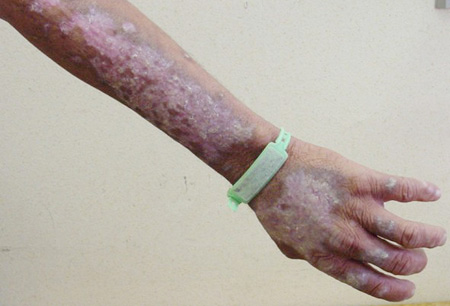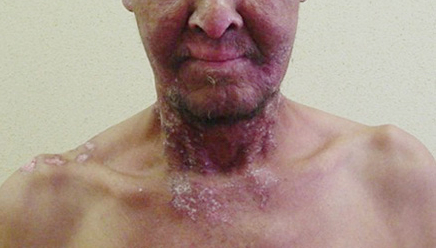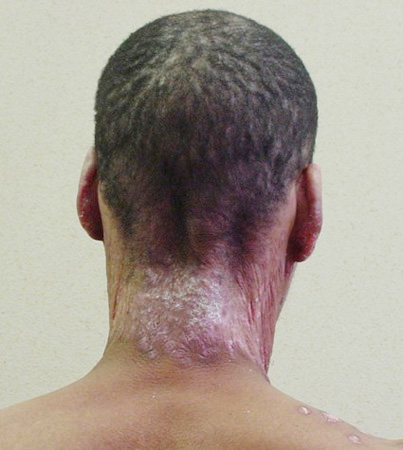History and exam
Key diagnostic factors
common
dermatitis
Cutaneous features begin with a symmetrical, bilateral, and well-defined erythematous rash similar in appearance to sunburn, on exposed areas of skin sensitive to sunlight.[81]
Dermatitis can rapidly become severe, characterized by hyperpigmentation, bullous lesions, and desquamation on exposed areas (e.g., face, neck, and arms).[43][Figure caption and citation for the preceding image starts]: Typical dermatitis of pellagra on sun-exposed skin (extensor aspect of forearm and dorsum of hand) that is clearly demarcated from unexposed skinFrom the collection of Demetre Labadarios [Citation ends]. [Figure caption and citation for the preceding image starts]: Typical dermatitis of pellagra on sun-exposed skin (face and anterior neck) that is clearly demarcated from unexposed skinFrom the collection of Demetre Labadarios [Citation ends].
[Figure caption and citation for the preceding image starts]: Typical dermatitis of pellagra on sun-exposed skin (face and anterior neck) that is clearly demarcated from unexposed skinFrom the collection of Demetre Labadarios [Citation ends]. [Figure caption and citation for the preceding image starts]: Typical dermatitis of pellagra on sun-exposed skin (posterior neck and ear helices) that is clearly demarcated from unexposed skinFrom the collection of Demetre Labadarios [Citation ends].
[Figure caption and citation for the preceding image starts]: Typical dermatitis of pellagra on sun-exposed skin (posterior neck and ear helices) that is clearly demarcated from unexposed skinFrom the collection of Demetre Labadarios [Citation ends].
Casal necklace occurs in advanced presentations and is characterized by erythema, hyperpigmentation, and scales around the neck.[28]
Dermatitis is not always present in pellagra.[7][8][56]
Other dermal symptoms include pruritic eruptions on the dorsum of the hand and distal forearm; erythema and slight scaling of the face, neck, and upper limbs; and nasolabial seborrhea and vulvovaginitis.
Repeated exposure to ultraviolet light leads to butterfly erythema on the face, persistent dermatitic plaques, telangiectasia, and poikilodermatous changes.[83]
insomnia, depression, or memory loss
Neurologic features of pellagra include insomnia, depression, or memory loss.
intermittent stupor
Neurologic feature of pellagra.
hallucinations or delirium
Neurologic features of pellagra include hallucinations and delirium.
weakness
Neurologic features of pellagra include weakness and paralysis of the extremities.
peripheral neuropathy
Neuropathic signs are common and difficult to distinguish from other types of polyneuropathy.
cogwheel rigidity
Reported in patients with pellagrous encephalopathy secondary to chronic alcohol use disorder.
primitive reflexes
Primitive reflexes (grasping and sucking) might be seen in patients with pellagrous encephalopathy secondary to chronic alcohol use disorder.
ataxia
Reported in patients with pellagrous encephalopathy secondary to chronic alcohol use disorder.
nausea, vomiting, or diarrhea
Gastrointestinal features of pellagra include nausea, vomiting, and diarrhea.
Other diagnostic factors
common
fatigue
Neurologic features of pellagra include insomnia and fatigue.
anxiety or paranoia
Neurologic features of pellagra include anxiety or paranoia.
anorexia, weight loss, or cachexia
Gastrointestinal features of pellagra include anorexia, weight loss, and cachexia.
uncommon
headache
Neurologic feature of pellagra.
vertigo
Neurologic feature of pellagra.
incontinence
Reported in patients with pellagrous encephalopathy secondary to chronic alcohol use disorder.
constipation
Uncommon gastrointestinal feature of pellagra.
heartburn
A burning sensation after eating food.
angular palpebritis
Redness and fissuring of eyelid corners (angular palpebritis) is an uncommon manifestation of vitamin B3 deficiency.
Risk factors
strong
malnutrition
Vitamin B3 is obtained only from the diet or supplements.[3] Primary vitamin B3 deficiency results from a diet deficient in niacin and/or tryptophan and is therefore frequently associated with poverty and malnutrition (usually undernutrition from a diet poor in nutrient quantity and quality).[55] Consumption of a corn-based, low-protein diet, or a vegan diet (no animal products) with few niacin sources, predisposes to the development of vitamin B3 deficiency.[1][3][8]
In developing countries, vitamin B3 deficiency is high across all households, and more pronounced in those living in urban areas, as a result of lower levels of micronutrient intakes being associated with shortfalls in protein-energy intake.[55]
In developed countries, vitamin B3 deficiency rarely occurs alone, as good sources of niacin and tryptophan are also sources of other B vitamins, such as B2 and B6, and these vitamins are relatively widely distributed in animal products, legumes, and fortified cereals.
Good sources of niacin include lean meats, liver, poultry, fish, beans, peanuts, and yeast. Milk and green leafy vegetables provide smaller amounts. Milk, meat, and eggs are good sources of tryptophan, the precursor of niacin. In the US and other developed countries, many cereals are fortified with niacin.
chronic alcohol use disorder
This is a strong risk factor in the presence of malnutrition and can lead to pellagrous encephalopathy.[30][31][32][7][33][34] Clinical features include confusion, oppositional hypertonus and myoclonus, insomnia, hallucinations, ataxia, tremor, seizures, peripheral neuropathy, and depression.[32][7] Urinary and fecal incontinence may also be present. Due to frequent coexistence of other encephalopathies, pellagrous encephalopathy is often not recognized in these patients.[32][56] Characteristic microscopic analysis at post mortem shows chromatolysis of neurons in the CNS.[32][57]
vitamin B2 (riboflavin) deficiency
vitamin B6 (pyridoxine) deficiency
malabsorption
Malabsorption may be secondary to Crohn disease, Roux-en-Y bariatric surgery, or other causes of the short bowel syndrome.[58]
eating disorders
Pellagra may be a secondary outcome of eating disorders, such as anorexia nervosa and bulimia nervosa.[22][23][24][25][17] Forty different dermatologic signs have been associated with eating disorders and these signs are generally present in patients.[59] Awareness of these dermatologic signs may assist in the diagnosis of anorexia nervosa and bulimia nervosa.[60] The most common symptoms of anorexia nervosa are glossitis, stomatitis, and cutaneous signs, such as erythema on sun-exposed areas.[59] Other nonspecific symptoms are mostly of a neuropsychiatric and gastrointestinal nature.[8]
Hartnup disease
This is an autosomal recessive disease characterized by impaired transport (gastrointestinal absorption and renal reabsorption) of neutral amino acids, including tryptophan (the precursor of niacin), resulting in a characteristic pattern of neutral aminoaciduria.[61][62][63][64][65] Symptoms include a photosensitive dermatitis, cerebral ataxia, and delirium. These symptoms usually resolve with niacin therapy. Short stature is seen in some patients.
carcinoid syndrome
Circulating neuroendocrine mediators produced by carcinoid tumors can lead to carcinoid syndrome. It is found in less than 10% of patients with cancer and is particularly associated with carcinoid tumors of the midgut.[66][67] Symptoms include diarrhea, flushing, and wheezing, as well as cardiovascular symptoms.[68][69] Pellagra is due to the depletion of tryptophan, the precursor of niacin, which is used by carcinoid tumors for serotonin synthesis.[37][38]
antituberculous drugs
Isoniazid has a similar structure to niacin and therefore interferes with the conversion of tryptophan to niacin by inducing a deficiency of the coenzyme pyridoxine. Isoniazid can thus cause pellagra.[48][49][50][51][47]
Rifampin inhibits the absorption of niacin and is also associated with the development of pellagra.
Crohn disease
This is a chronic, granulomatous inflammatory disease of the gastrointestinal tract resulting in diarrhea and malabsorption. Pellagra is a secondary outcome to malabsorption of nicotinic acid in some patients with Crohn disease.[26][27][28][29] Suspected vitamin B3 deficiency in such patients should be confirmed by measuring the urinary excretion of vitamin B3 metabolites.
weak
HIV infection
copper deficiency
Copper deficiency, which can result from the chelating effect of penicillamine, can inhibit the conversion of tryptophan to niacin.[46]
certain drugs
Other drugs associated with the development of pellagra are pyrazinamide, ethionamide, fluorouracil, mercaptopurine, hydantoins, phenobarbital, chloramphenicol, estrogen-containing oral contraceptives, antidepressants, and penicillamine.[20][47][43][48] Penicillamine chelates copper, leading to copper deficiency and subsequent inhibition of the conversion of tryptophan to niacin. Women taking exogenous estrogens have been found to excrete elevated levels of xanthurenic acid.[35][36] Pyridoxine (coenzyme for kynureninase, an enzyme involved in the conversion of tryptophan to niacin) therapy normalizes xanthurenic acid excretion, suggesting that the conversion of tryptophan to niacin is adversely affected.
pregnancy and lactation
Pregnant women have been found to excrete elevated levels of xanthurenic acid.[35][36] Pyridoxine (coenzyme for kynureninase, an enzyme involved in the conversion of tryptophan to niacin) therapy normalizes xanthurenic acid excretion, suggesting that the conversion of tryptophan to niacin is adversely affected.
There is also an increased requirement for niacin during pregnancy and lactation.
age >65 years
Alzheimer disease
Use of this content is subject to our disclaimer